INTRODUCTION

So far 2022 has been a very interesting year, not just because both AMD and Intel released their newest CPU lines but also because NVIDIA and Intel released their new graphics card lines and even though it was a first for the latter the end result was quite good. That being said if you're a somewhat old gamer such as myself you know all too well that there's a serious lack of interesting PC games in the market today, compared at least to past years. Luckily according to what's scheduled to be released in 2023 that could change soon so it's no wonder that people are scrambling to upgrade their graphics cards during the holiday season. Just over a month ago AMD also unveiled their answer to NVIDIA's GeForce RTX 4070Ti/4080 cards, the Radeon RX 7900 XT/XTX models which are based on their next-generation RDNA 3 architecture and today I’ll be testing the XT variant.
For more than 50 years AMD has driven innovation in high-performance computing, graphics and visualization technologies. Billions of people, leading Fortune 500 businesses and cutting-edge scientific research institutions around the world rely on AMD technology daily to improve how they live, work and play. AMD employees are focused on building leadership high-performance and adaptive products that push the boundaries of what is possible.
Both the Radeon RX 7900 XT and XTX cards are the first ones to feature AMD's chiplet design which combines 5nm and 6nm process nodes (each node is optimized for specific jobs) to deliver up to 54% more performance per watt, up to 2.7X higher AI performance and up to 1.8X higher raytracing performance than their previous generation RDNA 2 architecture. AMD has equipped both cards with GDDR6 memory (20GB with 320-bit interface for the RX 7900 XT and 24GB with 384-bit for the RX 7900 XTX), dedicated infinity cache (80MB for the RX 7900 XT and 96MB for the RX 7900 XTX), DP and HDMI V2.1 ports, USB-C port and two 8pin power connectors (AMD decided to take this route instead of asking for the new 12VHPWR cables/adapters). The Radeon RX 7900 XT which i have here with me today packs a total of 84 RDNA 3 compute units, 5376 stream processors, 192 raster units (or render output units), 84 ray accelerators (or ray tracing cores), 336 texture mapping units and 6 shader engines. Of course, both the Radeon RX 7900 XT and the Radeon RX 7900 XTX sport technologies like AMD's FidelityFX Super Resolution (FSR) 2.2 for maximum performance and visuals (with FSR 2.3 and Fluid Motion Frames technology scheduled for 2023), radiance display engine for incredible color accuracy at up to 8K 165Hz (12-bit HDR with full coverage of the REC2020 color space), image sharpening, noise suppression which helps reduce ambient noise, anti-lag for faster input commands, smart access memory (performance boost when paired with an AMD Ryzen CPU), FreeSync for no image stuttering and tearing and AMD link which allows you to stream your Windows desktop and games to mobile devices, TVs and other Windows PCs. So, let's see what AMD has been up to lately with their latest Radeon RX 7900 XT graphics card.
SPECIFICATIONS AND FEATURES

PACKAGING AND CONTENTS
AMD uses a black box to ship the Radeon RX 7900 XT inside the front of which is taken by a product picture (part of it anyways).
At the rear we find a picture of the Adrenalin control panel and some of the cards highlights.
The moment you open the box AMD welcomes you over to the red team.
Aside the card itself inside the box you'll find a red team card and the user instructions.
THE RADEON RX 7900 XT
The Radeon RX 7900 XT is a rather compact card that measures 276mm in length, 113mm in height and takes up just 2.5 slots (the housing is mostly made out of aluminum).
In order to see how compact this card really is i placed it right next to the HOF GeForce RTX 3080 Ti by GALAX.
AMD has used a tri-fan solution (3x80mm) to keep temperatures in check.
Strangely enough the far right side is closed and this could negatively impact interior temperatures (i don't expect by much however).
Taking a look from the top makes me like the black and red color combination even more (this model however has no LEDs on it).
In order to make the Radeon RX 7000 line more accessible to the masses AMD used two typical 8pin power connectors.
The entire rear of the card features a nice black aluminum plate which is what you'd expect from such a card.
Worth pointing out is that the entire interior is basically one very large heatsink.
Moving at the front of the card we find two DP v2.1 ports (up to 4K/480Hz - 8K/165Hz), HDMI v2.1 port and a USB-C port.
The lack of LEDs is something that may disappoint some potential buyers, still this is a good looking card, aside quite a compact one as well.
TEST BED
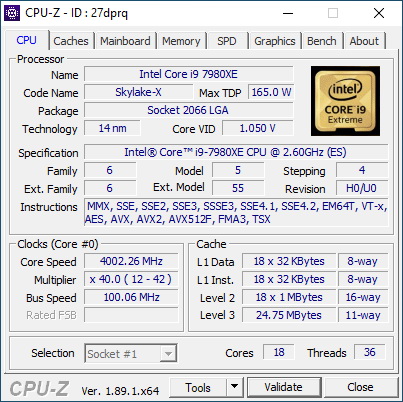

TESTING METHODOLOGY

Since we'll be using our latest test rig with our graphics cards tests, we also moved to another screen (Philips BDM4037UW) in order to also offer 4k Ultra HD tests. Of course, 2160p (3840x2160p) is not the only resolution we'll be testing cards with, we are also going to be testing them at 1080p Full HD (1920x1080p) and 1440p (2560x1440p). Also, because far too many gamers own Ultra-Wide screens at first i wanted to use our AOC AGON AG352UCG monitor in order to also have its resolution of 3440x1440p in our charts but since it's plugged into our other test rig several meters away from this one i really had to choose (and 4k seemed like the better choice). This time over we also updated the list of benchmarks/games to include the Time Spy benchmark by UL, Assassin's Creed Odyssey by Ubisoft, Devil May Cry 5 by Capcom, Dreadnought by Yager, GEARS 5 by The Coalition, Metro Exodus by 4A Games, Star Citizen by Cloud Imperium Games, The Outer Worlds by Obsidian Entertainment, Cyberpunk 2077 by CD Project* and DCS World by Eagle Dynamics**.
As with the past options like power saving, sharpness and overlays are all disabled in the cards we’re testing (to achieve maximum performance) and all tests are repeated a total of 3 times in a fresh Windows 10 Pro installation with all updates installed until the day of our review (same as all the games used). Room temperature is as usual controlled and steady at 23 degrees Celsius for all tests and to record the temperatures of the cards we used AIDA64 and GPU-Z. Recording noise levels is done with an ExTech HD600 dBA meter from a distance of no more than half a meter away (exterior of case) while power consumption is measured again using GPU-Z.
* Since February 2021
** Since August 2021
TEST RESULTS - 3DMARK TIMESPY

Time Spy was added in 3DMark back in 2016 with only 1 simple goal, to test the graphics of systems with Windows 10 and DirectX 12. Time Spy was used at default settings.



TEST RESULTS - ASSASSINS CREED ODYSSEY

Assassin's Creed Odyssey is an action role-playing video game set in the year 431 BC and the Peloponnesian War between Athens and Sparta and is based on the AnvilNext engine. For our tests we use the built-in benchmark of the game with FPS limit off, V-Sync off and the graphics set at high quality (because Assassins Creed Odyssey auto-detects your graphics card and sets settings accordingly the same graphics quality needs to be set manually every time).



TEST RESULTS - BORDERLANDS 3

Borderlands 3 is an action role-playing first-person shooter video game released back in late 2019 and is powered by Unreal Engine 4. Borderlands 3 has a very basic built-in benchmark which we set at DirectX 12 with unlimited frame rate and overall quality set to High.



TEST RESULTS - DEVIL MAY CRY 5

Devil May Cry 5 is an action-adventure hack and slash video game released in March 2019 and is based on the RE Engine like other titles by Capcom. Devil May Cry 5 doesn't feature his very own built-in benchmark so for that purpose we're using the latest version of Rivatuner Statistics Server with V-Sync Off, variable frame rate and all graphics settings set at High.


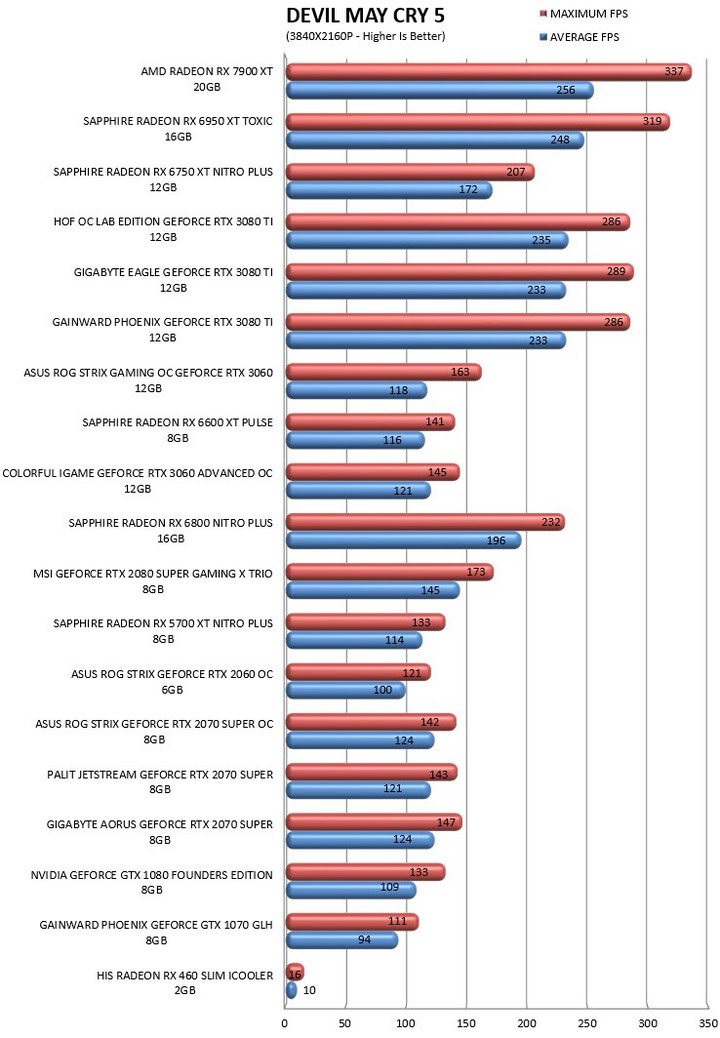
TEST RESULTS - DREADNOUGHT

Dreadnought is a space combat simulation game released for the PC in late 2018 and is the 3rd game in our tests based on the Unreal Engine 4. Dreadnought used to come with its own built-in benchmark but since that was removed, we decided to use Rivatuner Statistics Server with V-Sync off and graphics set to High (this game is capped after all so I removed that and did all tests again – unfortunately I no longer have all the cards here).



TEST RESULTS - GEARS 5
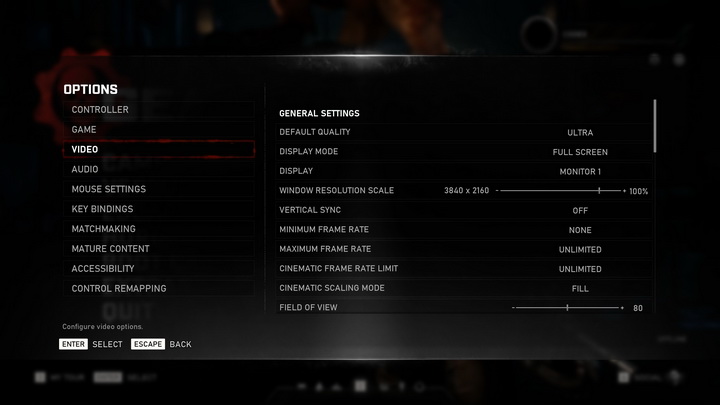
Gears 5 is a third-person shooter video game released back in mid-2019 and is powered by Unreal Engine 4 just like Borderlands 3. Gears 5 features a very convenient (not to mention fast) built-in benchmark which we use with V-Sync off, unlimited frame rate (none for minimum) and Ultra graphics quality.



TEST RESULTS - METRO EXODUS

Metro Exodus is a first-person shooter video game released in 2019 and is based on the 4A Engine. The latest game in the Metro series also features its very own benchmark utility which we set at DirectX 12 and Ultra graphics quality (we're also running RTX tests with that setting set at Ultra).


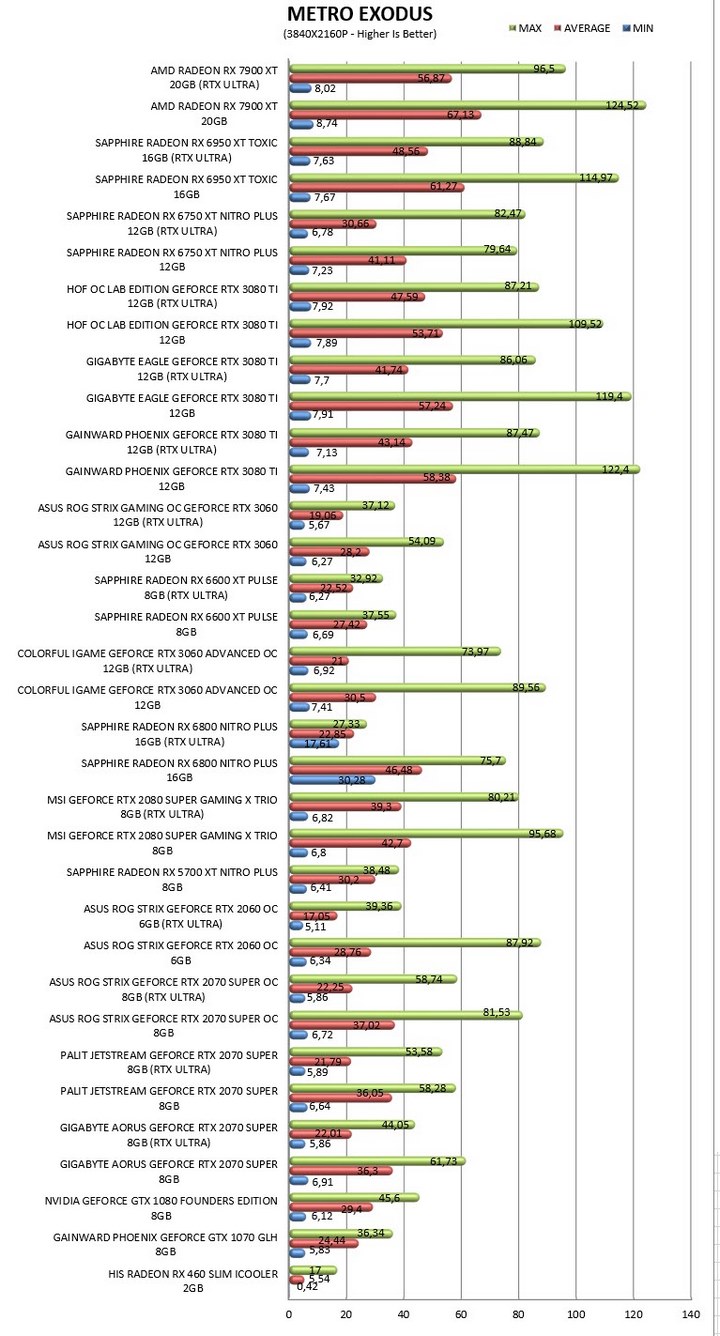
TEST RESULTS - STAR CITIZEN

Star Citizen is an upcoming multiplayer space trading and combat game the main development of which started back in 2012 and is currently based on the Lumberyard game engine. Not only does Star Citizen come without any built-in benchmark (or utility) but it’s still in Alpha status meaning that this is not the most stable game title to use for our benchmarks (numerous graphics optimisations are expected between now and launch day). Still, we wanted to have it in our charts for anyone interested and so we did by using Rivatuner Statistics Server with V-Sync turned off and the graphics set at High.



TEST RESULTS - THE OUTER WORLDS

The Outer Worlds is an action role-playing game released back in late 2019 and is also based on the Unreal Engine 4. The Outer Worlds is yet another title we had to use Rivatuner Statistics Server with V-Sync off, unlimited frame rate and graphics set at Very High.



TEST RESULTS – CYBERPUNK 2077

Cyberpunk 2077 is the latest game by CD Project and is based on their REDEngine 4. Benchmarks were run on game version 1.12 with all settings set at High and with the help of Rivatuner Statistics Server.

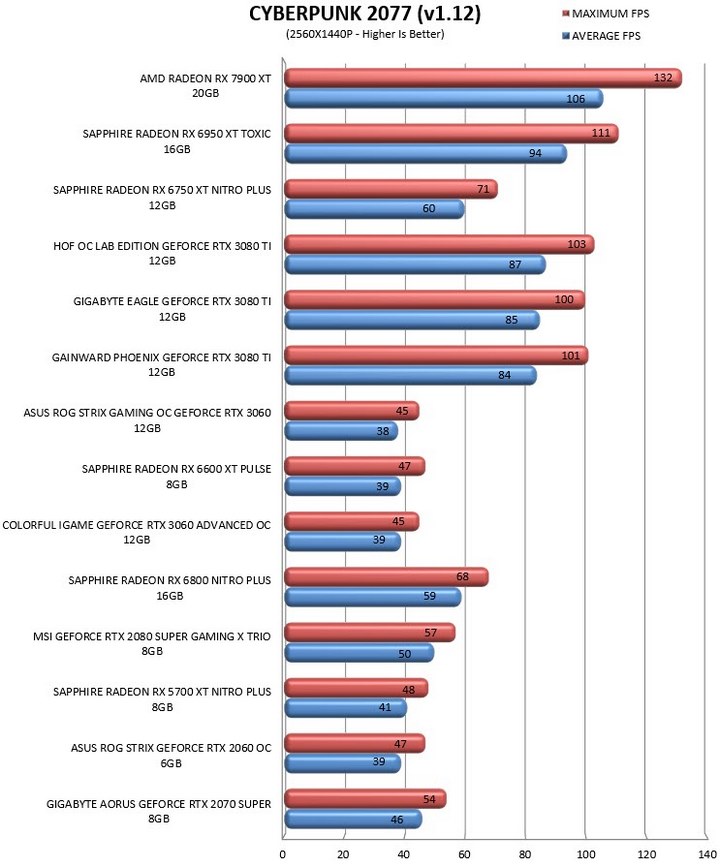
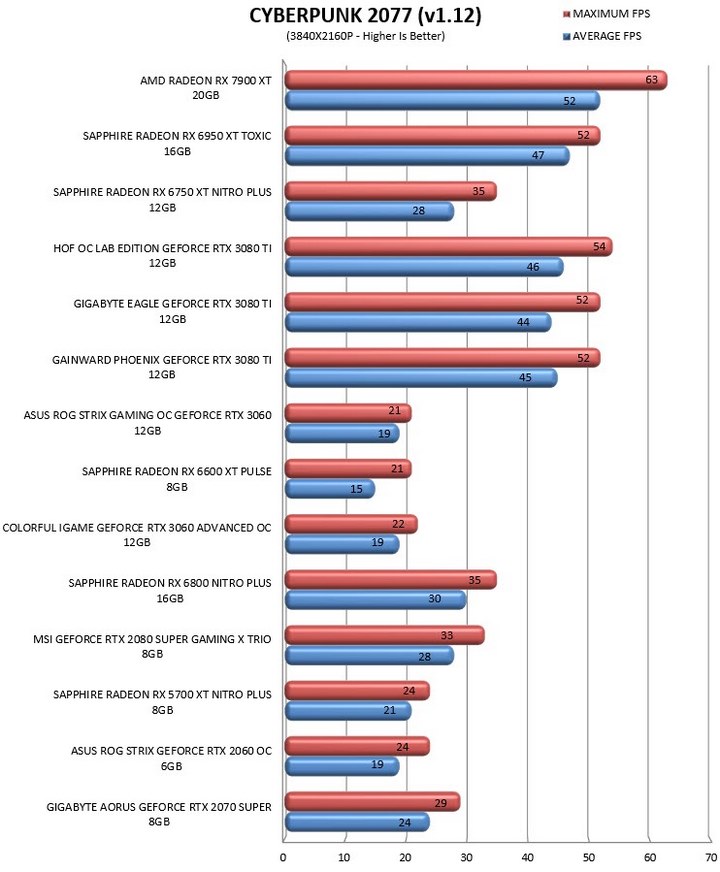
TEST RESULTS – DCS WORLD

DCS World by Eagle Dynamics is currently the leading combat flight simulator for the PC running on their very own in-house EDGE graphics engine. Benchmarks are run with graphics set on high with V-Sync off and once again with the help of Rivatuner Statistics Server.



TEST RESULTS - OVERCLOCKING

Going to 2650MHz boost, 2495MHz GPU and 2650MHz memory clocks was very easy (anything over that and most games would crash nonstop).
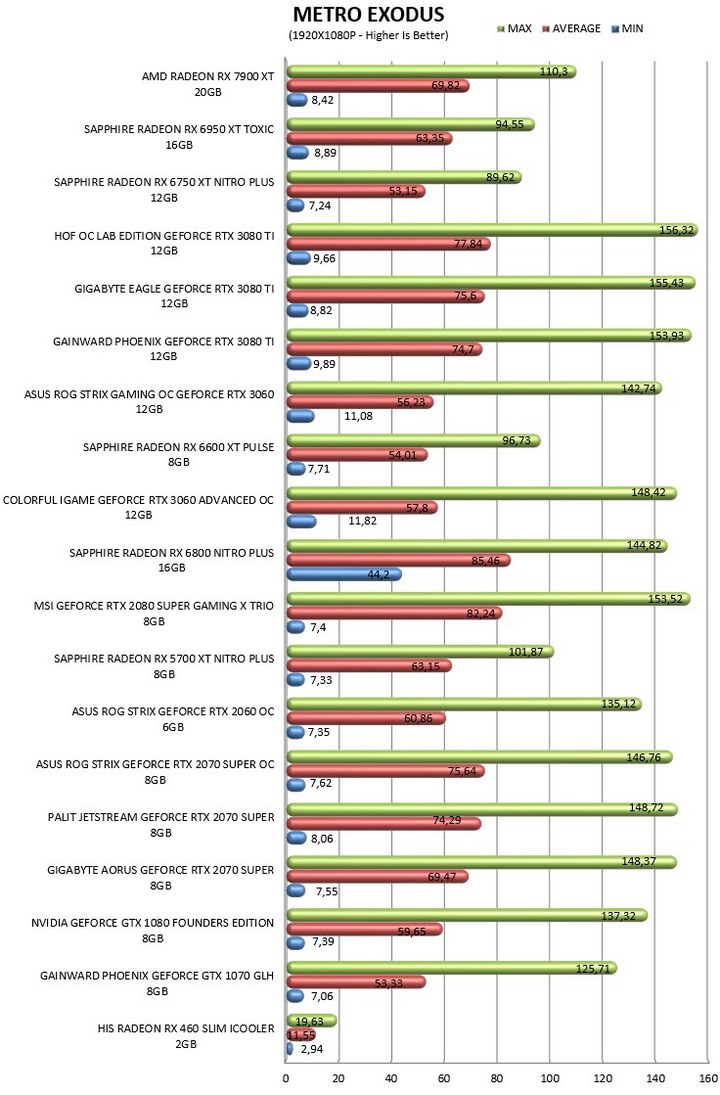





TEST RESULTS - POWER CONSUMPTION / TEMPERATURES / NOISE LEVELS



CONCLUSION
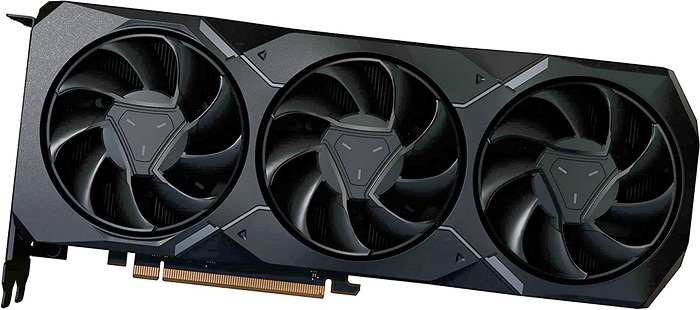
There are 3 things i think i need to point out before i close this review with my opinion on the brand new Radeon RX 7900 XT graphics card by AMD. First and foremost, this is the 2nd reference card i have in my charts, every other card is factory overclocked (and with improved cooling) which means that this isn't the fairest comparison (also do take into account that the drivers I used with most cards were mature ones and not launch drivers). I will be getting partner cards soon however which i expect to be slightly faster than this one. Second even though the maximum recorded power consumption during my tests (stress tests included) was at 350W while gaming the card never surpassed 341W. I know it's not that different of a number but i value accuracy above everything else. Finally, even though my Intel Core i9 7980XE system still holds up well (4GHz on all cores and 3.1GHz mesh) and during my tests the card never dropped beneath 99.23% utilization (and that was in 1080p tests) I’ll probably be using my new Intel Core i9 13900K system to perform future GPU tests. With these out of the way it's quite clear from all my charts that the Radeon RX 7900 XT is a very good card, at least overall. Yes, it may not blow its predecessor the Radeon RX 6950 XT out of the water (again, keep in mind that the Toxic model i have in my charts is factory overclocked and probably the fastest of that generation) but it does offer a 5-15% improvement in most games (raytracing performance included). Again, not having the reference Radeon RX 6950 XT here means i can't do a direct comparison but overall, the card could do a lot worse in both power consumption and temperatures (could be better however, as could noise levels). Technologies like FSR 2.2 and FreeSync work well as usual and so if you want more out of this card you can certainly get it. Using two 8pin power connectors with their new Radeon RX 7000 series is also certainly a plus since consumers aren't being forced basically to either get one of the new power supply units or one or more 12VHPWR adapters. Finally, size is always something I look for in a card. For example, the Sapphire Radeon RX 6950 XT Toxic has been one of my favourite graphics cards to date exactly because it’s so small and so I couldn’t skip appreciating just how compact the Radeon RX 7900 XT is (my guess is Sapphire will make something smaller again soon). Some driver related issues were expected so for example some games would crash to desktop and some tests wouldn’t finish sometimes but overall I can’t say I encountered something I haven’t in the past. Finally, it would be great if I could compare the Radeon RX 7900 XT and the XTX (review soon) with the GeForce RTX 4080 and 4090 cards (I imagine many of you are looking mostly for that today) but partner samples have yet to arrive (a couple should be here soon however).
The Radeon RX 7900 XT graphics card by AMD should be up for grabs tomorrow with an MSRP set at USD899 which is quite balanced although at USD999 the Radeon RX 7900 XTX will probably tempt gamers more (so AMD may end up working on their prices soon). Overall, the performance of the AMD Radeon RX 7900 XT may not be particularly impressive and I’m certain many people were expecting slightly more (partner cards may always deliver that) but it’s still a valid upgrade compared even to the previous generation flagship (and the Toxic version at that) and for that it definitely gets the Golden Award.

PROS
- Very Good Build Quality (Materials / Backplate)
- Top Of The Charts Performance
- Size (2.5 Slot / 276mm Long)
- Good Overclocking Headroom
- Supported Technologies
- Classic 8pin Power Connectors
CONS
- Price (Compared To The Radeon RX 7900 XTX Model)
- Noise Levels
- Overall RT Performance

 O-Sense
O-Sense





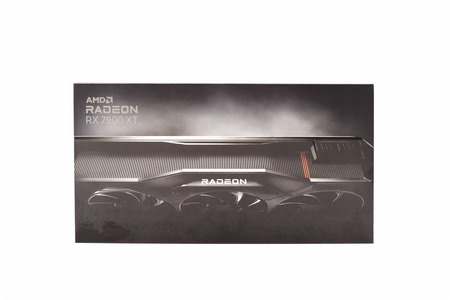


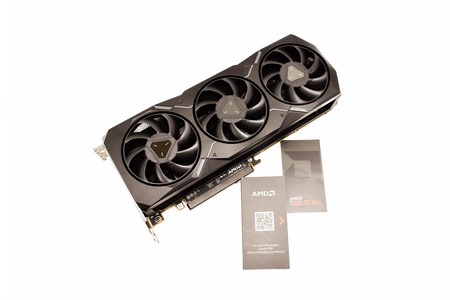












.png)

